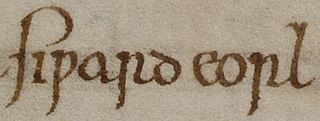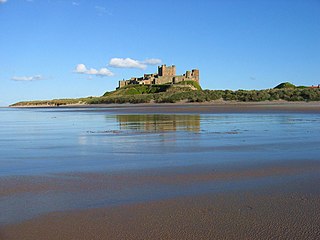
Máel Coluim mac Cináeda was King of Alba (Scotland) from 1005 until his death in the year 1034. He was one of the longest-reigning Scottish kings of that period.

Siward or Sigurd was an important earl of 11th-century northern England. The Old Norse nickname Digri and its Latin translation Grossus are given to him by near-contemporary texts. It is possible Siward may have been of Scandinavian or Anglo-Scandinavian origin, perhaps a relative of Earl Ulf, although this is speculative. He emerged as a regional strongman in England during the reign of Cnut. Cnut was a Scandinavian ruler who conquered most of England in the 1010s, and Siward was one of many Scandinavians who came to England in the aftermath, rising to become sub-ruler of most of northern England. From 1033 at the latest, he was in control of southern Northumbria, present-day Yorkshire, governing as earl on Cnut's behalf.
In Anglo-Saxon England, the Earl of York or Ealdorman of York was the ruler of the southern half of Northumbria. The titles ealdorman and earl both come from Old English. The ealdormanry (earldom) seems to have been created in 966 following a period when the region was under the control of Oswulf, already high-reeve of Bamburgh in northern Northumbria, from about 954, when Norse rule at York came to an end.
Aldhun of Durham, also known as Ealdhun, was the last Bishop of Lindisfarne and the first Bishop of Durham. He was of "noble descent".
Earl of Northumbria or Ealdorman of Northumbria was a title in the late Anglo-Saxon, Anglo-Scandinavian and early Anglo-Norman period in England. The ealdordom was a successor of the Norse Kingdom of York. In the seventh century, the Anglo-Saxon kingdoms of Bernicia and Deira were united in the kingdom of Northumbria, but this was destroyed by the Vikings in 867. Southern Northumbria, the former Deira, then became the Viking kingdom of York, while the rulers of Bamburgh commanded territory roughly equivalent to the northern kingdom of Bernicia. In 1006 Uhtred the Bold, ruler of Bamburgh, by command of Æthelred the Unready became ealdorman in the south, temporarily re-uniting much of the area of Northumbria into a single jurisdiction. Uhtred was murdered in 1016, and Cnut then appointed Eric of Hlathir ealdorman at York, but Uhtred's dynasty held onto Bamburgh. After the Norman Conquest the region was divided into multiple smaller baronies, one of which was the earldom of Northumberland, with others like the earldoms of York and numerous autonomous liberties such as the County Palatine of Durham and Liberty of Tynedale.
Gospatric or Cospatric, , was Earl of Northumbria, or of Bernicia, and later lord of sizable estates around Dunbar. His male-line descendants held the Earldom of Dunbar, later known as the Earldom of March, in south-east Scotland until 1435, and the Lordship and Earldom of Home from 1473 until the present day.
Eadwulf or Eadulf was ruler of Bamburgh in the early tenth century. A genealogy in the twelfth-century text De Northumbria post Britannos recording the ancestry of Waltheof Earl of Northampton, makes Eadwulf the son of Æthelthryth daughter of Ælla, King of Northumbria, but no source names Eadwulf's own father.
Eadulf IV or Eadwulf IV was the earl of Bernicia from 1038 until his death. He was a son of Uhtred the Bold and his second wife Sige, daughter of Styr Ulfsson. Eadwulf had one full sibling, a younger brother Gospatric. He succeeded his older half-brother Ealdred, who was murdered by the son of Thurbrand the Hold in a bloodfeud started when Thurbrand murdered Uhtred. The Anglo-Saxon Chronicle asserts that in 1041 Eadwulf was "betrayed" by King Harthacnut. The "betrayal" seems to have been carried out by Siward, Earl of Northumbria; when the Libellus de exordio and other sources write about the same event, they say that Siward attacked and killed Eadulf. Siward then became earl of all Northumbria, perhaps the first person to do so since Uhtred the Bold. Eadulf was the last of the ancient Bernician line of earls to rule, until his son Osulf usurped the Northumbrian earldom in 1067.
Uhtred of Bamburgh, was ruler of Bamburgh and from 1006 to 1016 the ealdorman of Northumbria. He was the son of Waltheof I, ruler of Bamburgh (Bebbanburg), whose family the Eadwulfings had ruled the surrounding region for over a century. Uhtred's death by assassination was described in De obsessione Dunelmi and has been interpreted as the beginning of a blood feud. Not to be confused with Uhtred the son of Eadwulf I of Bamburgh, which is why he historically has been referred to as Uhtred the Bold.
Waltheof was high-reeve or ealdorman of Bamburgh. He was the son of Ealdred, and the grandson of Oswulf I and was father of Uhtred the Bold, Ealdorman of Northumbria.

The Battle of Carham was fought between the English ruler of Bamburgh and the king of Scotland in alliance with the Cumbrians. The encounter took place in the 1010s, most likely 1018, at Carham on Tweed in what is now Northumberland, England. Uhtred, son of Waltheof of Bamburgh, fought the combined forces of Malcolm II of Scotland and Owen the Bald, king of the Cumbrians. The result of the battle was a victory for the Scots and Cumbrians.
Eadwulf III of Bamburgh or Eadwulf Cudel or Cutel was ruler of Bamburgh for some period in the early eleventh century. Following the successful takeover of York by the Vikings in 866/7, southern Northumbria became part of the Danelaw, but in the north English rulers held on from a base at Bamburgh. They were variously described as kings, earls, princes or high-reeves, and their independence from the kings of England and Scotland is uncertain. Uhtred the Bold and Eadwulf Cudel were sons of Waltheof, ruler of Bamburgh, who died in 1006. He was succeeded by Uhtred, who was appointed by Æthelred the Unready as earl in York, with responsibility for the whole of Northumbria. Uhtred was murdered in 1016, and king Cnut then appointed Erik, son of Hakon, earl at York, while Eadwulf succeeded at Bamburgh.
Ealdred was an Earl in north-east England from the death of his uncle, Eadwulf Cudel, soon after 1018 until his murder in 1038. He is variously described by historians as Earl of Northumbria, Earl of Bernicia and Earl of Bamburgh, his stronghold on the Northumbrian coast. He was the son of Uhtred, Earl of Northumbria, who was murdered by Thurbrand the Hold in 1016 with the connivance of Cnut. Ealdred's mother was Ecgfrida, daughter of Aldhun, bishop of Durham.
De obsessione Dunelmi is an historical work written in the north of England during the Anglo-Norman period, almost certainly at Durham, and probably in either the late 11th or early 12th century.
Northman was a late 10th-century English earl, with a territorial base in Northumbria north of the River Tees. A figure with this name appears in two different strands of source material. These are, namely, a textual tradition from Durham witnessed by Historia de Sancto Cuthberto and by the Durham Liber Vitae; and the other an appearance in a witness list of a charter of King Æthelred II dated to 994. The latter is Northman's only appearance south of the Humber, and occurred the year after Northumbria was attacked by Vikings.
Ælfhelm was the ealdorman of Northumbria, in practice southern Northumbria, from about 994 until his death. An ealdorman was a senior nobleman who governed a province—a shire or group of shires—on behalf of the king. Ælfhelm's powerful and wealthy family came from Mercia, a territory and former kingdom incorporating most of central England, and he achieved his position despite being an outsider. Ælfhelm first appears in charters as dux ("ealdorman") in about 994.

The Rulers of Bamburgh were significant regional potentates in what is now northern England and south-eastern Scotland during the Viking Age. Sometimes referred to in modern sources as the Earldom of Bamburgh, their polity existed for roughly two centuries, beginning after the attacks on the Anglo-Saxon Kingdom of Northumbria by the Vikings in the later ninth century, and ending after the Norman Conquest later in the eleventh century. In Scottish and Irish sources of the period the Bamburgh 'earldom' is referred to as the kingship of the Northern English, or simply of the 'Saxons'.
Thurbrand, nicknamed "the Hold", was a Northumbrian magnate in the early 11th century. Perhaps based in Holderness and East Yorkshire, Thurbrand was recorded as the killer of Uhtred the Bold, Earl of Northumbria. The killing appears to have been part of the war between Sweyn Forkbeard and Cnut the Great against the English king Æthelred the Unready, Uhtred being the latter's chief Northumbrian supporter. Thurbrand may also have attested a charter of 1009 and given a horse to Æthelred's son Æthelstan Ætheling. The killing is the first-known act, if it did not initiate, a bloodfeud between Thurbrand's family and Uhtred going into the time of Earl Waltheof. It is possible that Holderness took its name because of Thurbrand's presence or ownership of the peninsula.
Ligulf was an Anglo-Danish nobleman with landholdings in the north of England.





